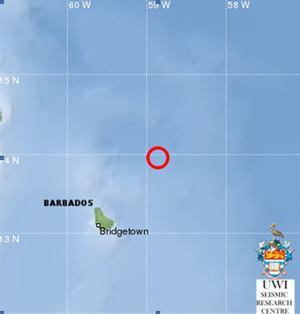Bridgetown, Barbados, July 16th, 2015 (CDEMA) – Several of the CDEMA Participating States were shaken today by a burst of earthquakes north-east of Barbados. The Seismic Research Centre at the University of the West Indies, St. Augustine, Trinidad, reported that the first earthquake occurred around 7.01 a.m. this morning, and registered a magnitude of 5.9. This was followed by a 6.4 magnitude earthquake at 11.16 a.m. and three other events measuring 4.1 and 5.3 and 3.8 respectively. The sequence is still on-going.
The 6.4 magnitude earthquake was reportedly felt in Barbados, Dominica, St. Vincent and the Grenadines, Saint Lucia, Grenada, Guyana, Suriname and Trinidad and Tobago. No tsunami warnings were issued for the Caribbean.
The UWI Seismic Research Centre noted that the earthquakes that occurred North East of Barbados are not unusual since the Eastern Caribbean is seismically active and will continue to experience earthquakes now and well into the future. Director of the Centre, Dr Richard Robertson said “the earthquakes today reinforce the need for much greater effort to be made towards building resilience to earthquakes in the region. It is not too late to learn from the lessons of Haiti”
The CDEMA Coordinating Unit contacted National Disaster Offices of the countries and was informed that these earthquakes did not cause any causalities or damage to infrastructure.
Ronald Jackson, Executive Director of CDEMA, said “the earthquakes today remind us of how vulnerable we are to seismic hazards in the region. This should also be a reminder to member states of the importance of strengthening first responder capabilities and further underscores the urgency of building national capacities for potential catastrophic events.”
He also added, “The event emphasizes the importance of a Comprehensive Disaster Management approach, as the Caribbean is not only exposed to climate related hazards but also to other hazards such as seismic related events.”
The CDEMA Coordinating Unit takes this opportunity to remind the public of the precautions for earthquake events.
The map to the right shows the general locations of the earthquakes.
During an Earthquake we should
Minimize your movements to a few steps to a nearby safe place and stay indoors until the shaking has stopped and you are sure exiting is safe. Be aware that some earthquakes are actually foreshocks and a larger earthquake might occur.
It is important to take quick action to be safe when the ground first starts to shake.
Don't wait until you're certain an earthquake is actually occurring.
At the first sign of the earth shaking, if you are in a building, stay inside and away from windows.
Drop, Cover, and Hold on.
DROP under a heavy desk or table,
COVER your head and torso, and
HOLD ON to the furniture. If you can't get under something strong, go to an interior wall and sit with your bottom and feet flat on the floor and protect your head. If you are outside, go to an open area.
Stay away from the kitchen. The kitchen is the highest hazard area in the home. There may be moving appliances and flying dishes. There may be gas or water pipes leaking. This may lead to fire or flooding
After an Earthquake
We should:
- Check for fires
- Check Utilities - shut off if necessary
- Check your house for serious damage - evacuate if there's threat of collapse
- Check for injuries - administer First Aid
- Be prepared for more earthquake tremors or aftershocks
- Turn on a transistor radio for emergency bulletins.
- Stay away from landslide-prone areas.
- Stay away from buildings that may have been damaged or weakened by the earthquake
- Be aware of Tsunami Threats – move away from direct coastal areas
We should not:
- Light a match or turn on a light switch. Use a flashlight!
- Touch fallen power lines
- Go to the beach to watch for giant sea waves
- Go sightseeing! Keep the streets clear for the passage of emergency and rescue vehicles
- Attempt to move seriously injured persons unless they are in danger of further injury
- Use your telephone, except for a medical or fire emergency.
For more information on earthquake safety please visit www.weready.org)
If you felt this event please visit the Seismic Research Centre at www.uwiseismic.com and complete the SRC Did you feel it? form or send an email to
